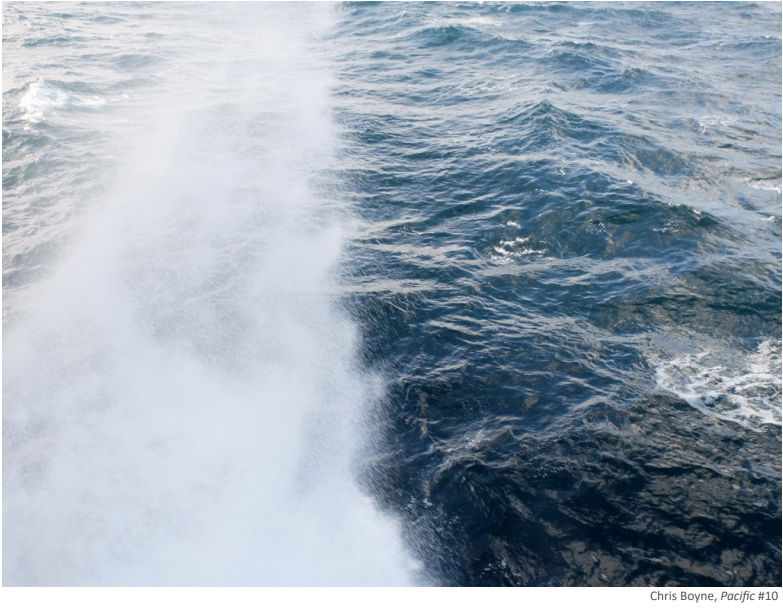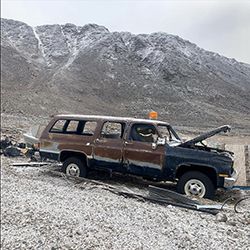Squarebody Resolute: A Conversation with Chris Boyne
On his website, Chris Boyne describes his artistic practice this way:
I use task-based approaches to explore ideas and generate content. These tasks are defined and then carefully worked through…. The work is open ended, and room is left for alternative narratives and outcomes…. I am interested in generative approaches and take an active role creating scenarios, setting activities in motion, sourcing and manipulating objects and making images.
Curious about this statement and intrigued by the cryptic language and near-obsessive research that form the backbone of his recent book project, seventy six, I asked him to talk more about his work.
What follows is excerpted from our conversations in May of 2023.
I originally made the decision to study just photography, and I chose the photo program at TMU because it did not have a foundation year – you could plunge right into photography. But later, at Concordia, I walked into a painting studio, and it was a mess – there was paint all over the floor – and I suddenly saw something about artmaking as an active process.
Doing my thesis work, I became more and more intrigued with labor, with texts, and with history, and started to ask myself, “What is the work of photography?” Is it the image? Using the camera? Making the negative? Doing a book? And I realized it was all those things. I began to want an active role in my art practice, and photography by itself felt too passive. So I settled on the idea of assigning myself a task, something which would involve having a specific goal.
The first of these projects was rebuilding a truck, but I ran into health problems and couldn’t complete it: I contracted Lyme disease while clearing brush to get the truck into the work space I had organized. Nonetheless, from the ashes of this project came something new, which felt like a gift: while I would never really know a project’s outcome ahead of time, I could always learn the skills to at least work towards what I wanted.
For more, see https://www.chrisboyne.com/stepside.
seventy six [https://www.chrisboyne.com/seventy-six] was a good exercise in this way of working. There were some direct and some meandering paths, but it was very rewarding, and brought me to a sense of where I am now. Autobiography is something that uses what I would call a piffling part of my brain, but it also leads to catharsis and self-revelation. Parts of this book are complex and inaccessible, parts are therapeutic and confessional, but every entry deals with something I struggled with and couldn’t forget. Working through all this was almost ritualistic, but it brought me some release.
What I’m working on now, Squarebody Resolute, is related to the original truck project. Squarebody trucks were manufactured by GMC and Chevrolet between 1973 and 1987, and I have been posting photographs of them since 2014 at https://www.instagram.com/white_chev/. To date, I’ve located and photographed nearly four hundred, in Canada, the USA and Mexico. Each truck is numbered and catalogued, with descriptive text that includes special features and location.
You can find page after page of other photographs on Instagram – the day I searched, the very first image to appear was captioned, “Remember when trucks looked this good?”
One thing led to another, and eventually I made enough contacts and connections that a project could form in my mind.
These trucks can be found all over the High Arctic – Resolute, Grise Fjord, places like that – they were brought there for use by the RCMP, Natural Resources Canada and other government agencies. They arrive on the annual supply ships which are the lifeline of these communities, but shipping tends to be a one-way process: the ships go North full, and mostly return empty. The trucks were abandoned in place: they are worn out, abused or vandalized, but in that environment they don’t rust, the metal remains intact. And these vehicles were made to government specifications, with heavy-duty axles and transmissions – they are plain, but durable and built to high specifications.
I plan to locate one of these trucks and pay to return it to Montreal via supply ship, documenting the process as logistics permit. The project will be an act of reconciliation: reclaiming trash, bringing a truck back from where it was left, coming full-circle via a kind of recycling. Most squarebody trucks have been scrapped, but others were kept for parts, and some have been restored…. Objects hold different values in different realms. This truck would hold value as an art object, and I would have authorship of that value. I would go in August, return with the truck in September. It would be on display only briefly, as a bizarre kind of time capsule.
I’m always looking for a way out of preconceived ideas or rigidity, always trying to find a new path. Art can be so many different things — people need to understand that, or else they tend to hang on to past forms and ways of working. You need to be always thinking, planning, making –and always resilient.
Boyne’s work can be found at https://www.chrisboyne.com/.
His deep interest in transportation, maritime environments and shipping can be accessed via
these (and other) links:
https://www.chrisboyne.com/black-nance
https://www.chrisboyne.com/Geneva
https://www.chrisboyne.com/a-conveyor-1
For his images of water, please visit https://chrisboyne.com/the-pacific


